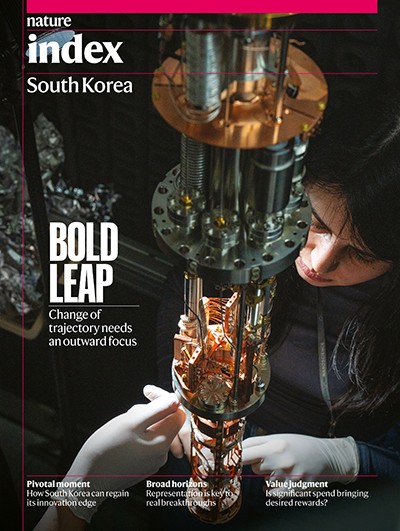Seoul National University (SNU), the largest public university in South Korea — where I have worked for nearly 40 years — has roughly 22,000 undergraduate students and a similar number of postgraduate students. Around 36% of undergraduates, and 49% of postgraduates, are women. The university’s 450-odd full-time female faculty members, by comparison, account for 19.7% of the total. As of 2022, nationally, across the academic, government and industry sectors, just 23% of the research workforce is female.
Nature Index 2024 South Korea
The fall in numbers that occurs during women’s research careers is a major concern. In South Korea, female students in STEM fields constitute 31% of university entrants, and as graduates — generally in their 20s — they are employed at similar rates to men in science and technology roles. But a significant gap emerges in their 30s and continues to their 50s, with a 30% difference in employment rates between men and women in these age groups. There are now roughly 180,000 women in science and technology roles in South Korea who are on a career break, whose return to workplace is urgently needed to shore up the country’s future in science and innovation.
Retention is not the only issue — inequitable access to research funding and leadership positions is another serious problem for South Korea. Out of the roughly 49,000 principal investigators (PIs) who are pursuing governmental research projects across the country, 17.7% are female. This number needs to increase at least two-fold over the next decade to reflect the proportion of female PhD students.
Equally important as the number of PIs is the amount of research funding that is available to them. In South Korean universities, the average amount of government funding won by male PIs in science and technology areas is 165 million won (US$119,393). For women, that figure is 67 million won.
We see further disparity in the number of PIs at universities who were pursuing large projects of more than 1 billion won in 2022; 1,100 men versus 70 women. Considering this gap — which is far wider than in countries such as the United States and United Kingdom — it is noteworthy that women PIs in South Korean universities produce more output per research expenditure than men, in both the total number of papers and the top 25% cited papers in Clarivate’s Science Citation Index.
Since 2001, South Korea has initiated programmes to support the country’s female early career researchers with salaries and its established researchers with grants. These programmes have certainly contributed to the growth of female PIs but have not closed the gap in research funding. Similarly, affirmative action by the government and legislative changes by the National Assembly over this period — many of which have been influenced by initiatives led by female researchers — have improved female faculty numbers in public universities, but do not go far enough.
In 2015, for example, the Association of Women Faculty Councils at National Universities in Korea — a nation-wide network launched through the efforts of the Women Faculty Council and Diversity Council at SNU— set out to highlight the stark gender imbalances in the university sector. This included the fact that public universities hired far fewer female faculty members (15% of the total faculty) than private universities (25%). This initiative prompted the Law on Public Officials in Education to be amended in 2020, recommending that a specific gender does not exceed 75% of faculty composition in public universities. Each university must now submit a yearly plan to achieve this goal until 2030.
Measures such as these have been a strong motivator for improving gender diversity in research, but new strategies are needed if South Korea is to achieve gender parity. Female representation at academic conferences needs be improved, for instance, and the government and funding agencies need to make more proactive measures to increase the number of women PIs in medium- and large-scale research projects.
More female professors need to be hired in science and innovation areas to meet the needs of the growing population of female students, which in engineering and the natural sciences have actually increased over the past 10 years, both in undergraduate and graduate level.
Faced with the fastest declining population in the world, South Korea must do more to bolster the ranks of its highly skilled workforce. Implementing the policies and initiatives necessary to improve the recruitment, retention and the upward mobility of women researchers is of utmost importance for the country’s future success.
Competing Interests
The author declares no competing interests.

